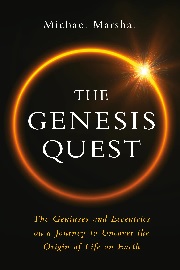The Genesis Quest: The Geniuses and Eccentrics on a Journey to Uncover the Origin of Life on Earth

Michael Marshall
The University of Chicago Press, £20.00
This book explores multiple theories about the origin of life and the story of how these ideas have progressed over the last century. The book's distinctive style comes from well-researched analysis of the behaviour and lifestyles of the various scientists who have contributed to this fascinating and uniquely difficult question.
The story effectively starts with the Russian scientist Alexander Ivanovich Oparin, a controversial figure working under Stalin who was the first person to publish a hypothesis of life’s origin that other scientists took seriously. He imagined simple blobs of organic material forming in the primeval seas, which became more complex and gave rise to living cells. This remarkable theorising 'opened up the question of life’s origin for other scientists, by giving them a working hypothesis to consider.'
By 1953 the famous Miller-Urey experiment presented hard evidence that the molecules
of life could form naturally from simple chemicals. Then came an abundance of differing theories on which exact environments on Earth provided the key conditions to create sustainable, complex, energy-harvesting cells. Was it within the crystal structure of the Earth's wet clay, or amid the extremes of energy found near deep-sea thermal vents?
The earliest theories ultimately failed because life was far more complex than any of these experimentalists and thinkers knew at the time. Later hypotheses like the 'RNA World' theory instead stripped life down to one of its key components: either a key replicating chemical or a process like energy use.
Marshall's conclusion of the latest thinking on this topic is that 'the first life was not based around a single component like a gene. Life began with all its major components, just in drastically simplified form...The chemical building blocks of life all form from the same raw materials, and once formed have a tendency to self-assemble into structures that crudely resemble living cells.'
The book is comprehensive in covering most notable experiments and philosophical thought on the subject, with extensive references cited. However, inevitably, it is selective, and notable omissions include Melvin Calvin’s book Chemical Evolution published in 1969, and the controversial book The Phenomenon of Man by the Jesuit priest and palaeontologist Pierre Teilhard de Chardin, published in 1955, outlining evolution as the transition from an abiotic state to a biotic state.
Whereas the focus is science and the stories of the scientists, there is some comment on theological implications - in commenting on the Urey-Miller experiment and the theory that the chemicals of life formed from a reducing atmosphere, Urey said: ‘If God did not do it this way then he missed a good bet.’ The epilogue of The Genesis Quest, on the meaning of life, should stimulate more experiments to be done, and on the search for life on other worlds quotes NASA in defining life as 'a self-sustaining chemical system capable of Darwinian evolution.'
This book is an extremely stimulating read and I recommend it most strongly to scientists and laymen alike.
Professor Jim Lynch OBE FRSB


